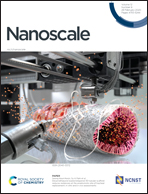Polydopamine-on-liposomes: stable nanoformulations, uniform coatings and superior antifouling performance†
Abstract
Polydopamine (PDA), a mussel-inspired synthetic polymer, affords biocompatible and antifouling coatings on a variety of surfaces. However, the traditional protocol of preparing PDA by polymerizing dopamine (DA) under basic conditions yields physically-unstable and non-uniform coatings that are prone to delamination and exhibit compromised antifouling performance in vivo. Here, we show that the high local pH in the vicinity of vesicular self-assemblies formed by a series of acetal-based cationic amphiphiles can be exploited to conveniently polymerise DA under physiological conditions in a gradual manner without requiring any external oxidant. Two of the four PDA–liposome nanoformulations viz. PDA-L1 and PDA-L2 turned out to be highly stable physically and resisted precipitation for more than a month while the other two formulations (PDA-L3 and PDA-L4) were less stable and formed visible precipitates with time. Further, the PDA-liposome formulations had significantly improved haemocompatibility compared to that of pristine liposomes. PDA-L1 formed highly uniform, nanostructured coatings on implants like catheter, cotton and bandages that did not delaminate even after a week of continuous incubation in simulated body fluid, or on exposure to pH change and presence of proteolytic enzymes. The PDA-L1 coated catheter implants resisted biofouling by both Gram-positive and Gram-negative bacteria in vitro and also had superior in vivo performance in mice vis-à-vis the implants coated with traditional base-polymerised PDA formulation (BP-PDA). Thus, these novel liposomal PDA nanoformulations significantly improve the practical utility of PDA-based coatings for antimicrobial applications.



 Please wait while we load your content...
Please wait while we load your content...